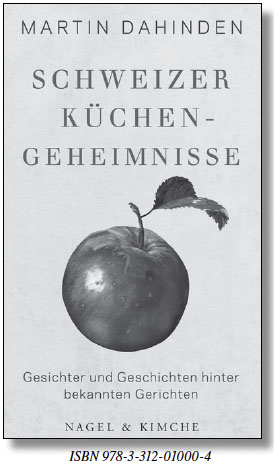Food and diplomacy
Food and diplomacy
by Sabine Vuilleumier
Since October 2014, Martin Dahinden has been the ambassador of Switzerland in Washington. In addition to many other tasks, he and his wife welcome up to 4,000 guests in his residence at around 400 culinary events each year. These events give him a perfect opportunity to present the strengths and characteristics of his country by means of food and people and historical events related to them. Upon invitation of the European Institute, he presented this part of his work and his book “Schweizer Küchengeheimnisse” (“Swiss Kitchen Secrets”), published in 2016, to the interested public at the University of Zurich.1
Food and cuisine have always played an important role in shaping diplomatic relations. Having a meal together offers a framework for the exchange of information and negotiations, but can also express contents and be a form of communication. Up to the middle of the last century classical French cuisine dominated the world of diplomacy, since then national cuisines have become more important. “This change is an expression of equality, the sovereignty of all states that has been enshrined in international law after the Second World War.”2 In international relations, food has become a sovereign appearance in the double sense of the word.
Limiting personal power
Typical Swiss dishes like “Bratwürste”, “Raclette”, “Zürcher Geschnetzeltes” tell a lot about our country and its population: They are simple, they come without flourishes, they are also accessible to all people entirely in the spirit of Swiss political culture. Martin Dahinden doubts, however, that these dishes show that Switzerland is one of the most globalised countries, an economic and scientific “powerhouse”, and one of the most innovative countries on our planet. In his book he therefore honors Swiss personalities, cooks, bakers and restaurateurs in 30 “culinary stories”. These include the most important cook of the Renaissance, the first woman to write a cookbook, the tragic fate of a man arranging pompous festivals for the Sun King, as well as pioneers of the hotel business and industrial food production.
In the course of his researches, Dahinden encountered many brilliant minds, but today they are largely forgotten. This might have to do with the republican virtue of distrusting outstanding personalities and to punish them with oblivion. The limitation of personal power has always been an important motive for federal state understanding.

Food culture as an expression of federalism
Ambassador Dahinden asked himself why, despite all the described culinary achievements, the discoveries and the inventiveness of outstanding chefs, no great Swiss cuisine has emerged. Since he did not find an answer to this question, he made his own: cuisine and food culture are an expression of political, economic, social and cultural conditions. “Federal Switzerland, a form of an independent small state, did not strive for a center of power and a geographical center. The Federal Diet of Switzerland took place at different places, a central administration with a firm seat emerged only with the founding of the modern federal state. To this day, Switzerland does not have a capital but merely a federal city, a seat of the important institutions of the Confederation.” (p. 161) and: A national Swiss cuisine would be contrary to the nature and social reality of the country. Precisely because the actors of Swiss cuisine were not restricted by any national cuisine, they made an astonishing contribution to culinary world history. Until today.”
Addressing current challenges in his work as an ambassador in the USA, Dahinden called for data security. It is very demanding to ensure that they could communicate without being intercepted. If you want to know what the new administration is really planning you will have to rely more on facts like the draft budget or legal documents. There are great contradictions between what is communicated and concrete action. However, his task as ambassador is, as before, to establish a good relationship with the new administration with a long-term perspective in order to achieve the economic interests of Switzerland and the aim of a fruitful scientific cooperation.
Martin Dahinden succeeds in conveying the political, social and cultural characteristics of Switzerland with the explanations in his book – in the sense of a good ambassador of his country. The rich, vivid written book is recommended for reading. •
1 Dahinden, Martin. Schweizer Küchengeheimnisse. Nagel & Kimche 2016.
2 <link http: www.eiz.uzh.ch vorträge oeffentliche-vortraege external-link website:>www.eiz.uzh.ch/vorträge/oeffentliche-vortraege/ (Film of the speech at the University of Zurich from 29.5.2017)
Martin Dahinden, born 1955, studied economics and history at the University of Zurich. Since 1987, he has worked in the Swiss diplomatic service in Geneva, Paris, Lagos, New York, Brussels and Berne. He headed the Geneva mining center and from 2008–2014 the Swiss Agency for Development and Cooperation (SDC).
Excerpt from the book:
“Helvetia: The Mother of the Nation as a culinary inspiration. The figure of Helvetia personifies Switzerland and at the same time it is an expression of an idea, of a political will. As a heroic and protective authority, it is a role model, and in this function, it gave its name to different courts, of course […]. Helvetia is usually portrayed as a defensive woman with a shield and a spear, more rarely with a sword or a bundle of lictors, which has been a symbol of power since the Roman Republic. […] The attributes that distinguish her from the other national mothers are important. In addition to the Swiss cross on the shield, there are mountain peaks, the alpine corn snow, edelweiss and alpine roses. The term Helvetia is the same in all four Swiss local languages. Therefore, the word Helvetia is also used today to represent Switzerland, for example, on stamps and coins. The term and the figure of Helvetia thus unite not only the cantons, but also the four language regions.” (p. 53) – This is followed by recipes for “Mousselines de truite Helvétia”, “Aloyau à l’Helvétia”, “Helvetia pate” and others.